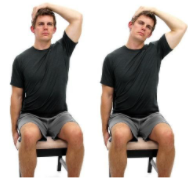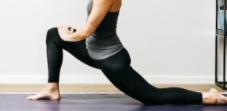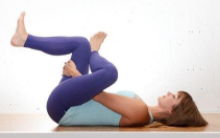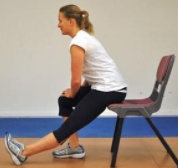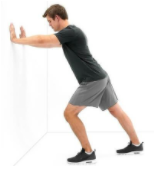
5 Stretches to Perform During your WFH Schedule!
March 5, 2021
By: Megan Deible, PTA
Since the COVID-19 pandemic has started, most people have turned to working remotely. If you are still working in the office, you are more than likely not as active pre-pandemic because of the business closures. Due to the influx of people sitting at home more, the muscles in our bodies are inevitably going to become tight as our daily routine has changed significantly. In this month’s blog post we will go over five stretches that can be done at home to relieve tension in some of the common areas on the body.
- Upper Trap Stretch
The upper Trapezius is located on the back of the neck and tends to become very tight from hunched shoulders or if we keep our shoulders shrugged, due to stress or tension. Most people carry their stress in this muscle causing it to become very tight. If the muscle tension is not resolved it can cause pain into the shoulder and neck region.
Stretch: Sitting with good posture, simply bend your head to one side and you should feel a stretch on the opposite side. If you do not feel much of a pull, you can use your hand to pull your head to the side or hold onto the chair you are sitting on with the same side you are trying to stretch.
2. Hip Flexor Stretch
There are several muscles that flex the hip and are primary located in the pelvic area and into the top front part of the thigh and are responsible for bringing the knee up to the hip. If tightness persists without resolution, it may cause an imbalance to the pelvis over time. The trunk could also flex forward making everyday tasks like walking and standing difficult if not fixed. Sitting all day at a desk shortens this muscle which causes it to become tight after prolonged sitting over an extended period. There are many ways to stretch out the hip flexors and ways to modify the stretch if needed.
Stretch: Starting in a kneeling position, shift your weight onto the leg in front and you will begin to feel a stretch on the leg that is in the back. It is important to keep the knee in front behind the toes, as seen in the picture. To get a more intense stretch, grab the foot in the back and pull up towards your bottom.
3. Piriformis stretch
The piriformis is a smaller muscle that extends from the sacrum to the top portion of the hip and plays a role in externally rotating the hip. This muscle lays on top of the sciatic nerve. This nerve runs from the low back and travels down the back of the leg into the foot. Prolonged sitting causes the piriformis to become tight which can have a negative effect on the sciatic nerve. If the piriformis is pinching the sciatic nerve it can cause numbness, tingling, and pain into the back of the leg also known as sciatica. The piriformis is not the only cause of sciatica but can contribute to the symptoms if tight.
Stretch: This stretch can be completed lying on your back or seated in a chair. Make a figure four with your legs and you will feel a pull in the bottom/glute region. To intensify, push or pull the leg that is on top, and it will increase the stretch.
4. Hamstring Stretch
The hamstrings are made up of three muscles: Biceps femoris, semimembranosus, and semitendinosus. Because there are three muscles, it is a very long and wide muscle. It extends from the bottom of the pelvis to the tibia and fibula making it a two-joint muscle. This means it has two actions: extends the hip and flexes the knee. Sitting for prolonged time can shorten the distal or bottom portion of the hamstrings. Over time, tension can cause an imbalance with the pelvis and can eventually cause disruptions with ambulation.
Stretch: Start in a chair and scoot to the edge. Extend the leg you want to stretch out in front, and you should feel a pull in the back of the leg. To increase the stretch, lean into the leg and the pull will intensify. This stretch can also be performed lying down or standing.
5. Calf Stretch
Like the hamstrings, there are three calf muscles: Soleus, Gastrocnemius, and plantaris. The two main calf muscles are the soleus and gastroc. The plantaris is a very small muscle and has the same attachment sites as the gastroc . The gastrocnemius muscle attaches from the distal femur and extends into the Achilles tendon. While the soleus also attaches into the Achilles tendon it originates on the tibia. The gastroc is a two joint muscle and is responsible for bending the knee and pointing the foot. The soleus only crosses one joint and is responsible for pointing the foot. The calf muscles are another muscle that tend to become tight with prolonged sitting.
Stretch: Standing in front of a wall or chair, extend the leg you want to stretch back. Then, shift your weight forward bending the leg in front. The pull should be felt in the calf of the leg in the back.
It is important to stretch at home especially with the increase in sedentary lifestyle due to the COVID- 19 pandemic. Over time, these muscles can become imbalanced and can cause pain or injury. A normal reaction to stretching is a pulling sensation. It should not be painful or become painful at any time during the stretch if done correctly. Each stretch can be done three times on each side for 30 seconds. If you find yourself with pain or stiffness at home, try the 5 stretches listed above and see if they provide relief. If not, don’t hesitate to call us at 540- 571-1970 to schedule an evaluation with us at Purcellville Orthopedic Physical Therapy. We can further investigate the root of the problem and get you an exercise and stretching regimen that will work for you! Please feel free to call us with any questions you may have!
